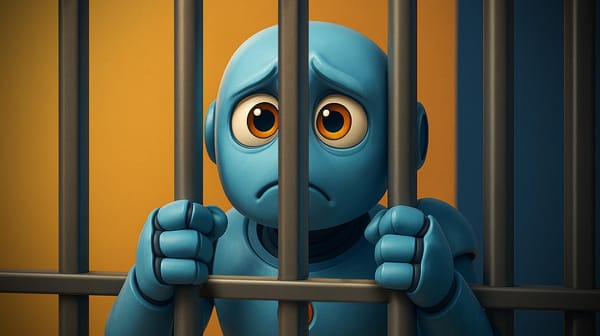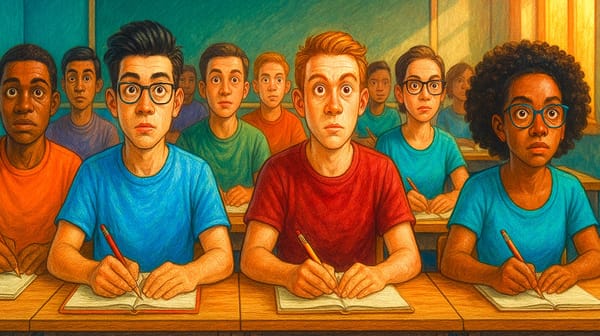The Plagiarism Police are Knocking
How AI-generated content is putting every marketer, agency, and brand at risk.

Imagine you’re a freelance content marketer with a reputation for high-quality blog articles and polished social campaigns. One morning, you open your inbox to a curt message from your biggest client: “We have a major problem—call me ASAP.” Turns out, they just discovered disturbing similarities between your recent piece and a competitor’s website copy. An online plagiarism checker shows entire phrases that, while not identical, are alarmingly close—close enough that the competitor is contemplating legal action.
Suddenly, you’re on the defensive. Did you inadvertently copy the text during your research? Or did the AI tool you used for “inspiration” just remix existing prose into something that isn’t as original as you thought? The truth hardly matters. Your client is furious, trust has evaporated, and the potential fallout could seriously impact your livelihood. That one email becomes a potent reminder: in an era saturated with AI-driven content, plagiarism isn’t just an academic concern. It’s a ticking time bomb for marketers, agencies, and brands of every size.
The Silent Epidemic
For years, marketers have boasted about “thinking like publishers.” Yet few have embraced the serious editorial standards real publishers live by. It’s easy to understand why: content marketing thrives on speed and volume—white papers, blog posts, social updates, newsletters. The more, the better. But as technology accelerates, old-fashioned cut-and-paste plagiarism is being overshadowed by a more insidious form of duplication, often enabled by the very AI tools that promise efficiency and productivity.
Ask any content marketer if they’ve ever borrowed heavily from a competitor’s work, or if they’ve used ChatGPT, Jasper, or Claude without thoroughly vetting the final output. You’ll see a nervous shuffle of feet, if not an outright denial. Still, industry surveys paint a sobering picture: plagiarism-detection companies report a significant portion of the content they scan contains substantial similarities to existing text. And as AI platforms become ubiquitous, that overlap is likely to grow.
Marketers often assume that if a passage isn’t lifted verbatim, it’s safe. That illusion shatters when you consider that “plagiarism” stretches well beyond exact quotes. Reusing someone’s distinctive structure or unique insight, patching together text from different sources, or even letting AI rearrange pre-existing language can cross the line. For brand managers and agencies that serve Fortune 500 clients, the reputational and legal stakes couldn’t be higher.
The Growing Tangle of AI IP Lawsuits
If you need proof that generative AI and intellectual property disputes are heating up, look no further than the ongoing legal battles involving tech giants, major media outlets, and high-profile individuals. In December 2023, The New York Times sued OpenAI and Microsoft, alleging their AI models were trained on Times articles without authorization. It was the first major lawsuit to highlight the stakes involved when influential media entities challenge AI companies over the use of their content. But it isn't the last.
Getty Images is suing Stability AI, alleging that the AI company used millions of Getty-owned images without permission to train its models. Authors Sarah Silverman, Christopher Golden, and Richard Kadrey are among writers suing Meta and OpenAI, claiming their books were scraped without consent. And then there's Thomson Reuters v. Ross Intelligence; Brave Software v. News Corp; UMG Recordings v. Suno ... The list goes on.
The implications for marketers are clear. If massive corporations with robust legal teams can find themselves in hot water over how AI obtains and repurposes content, what chance does a lone freelancer or small agency have of dodging scrutiny? The line between “inspiration” and “appropriation” is murkier than ever. It’s not a stretch to imagine a near-future scenario where brands and marketing agencies face lawsuits for using AI-generated copy or visuals that too closely resemble another brand’s intellectual property.
Why AI Amplifies the Risk
Until recently, plagiarism in marketing often took the form of intentional copy-and-paste from outside sources or innocently “reusing” someone else’s brand voice. But AI has introduced a more complex dynamic. LLMs are incredibly adept at synthesizing language from mountains of training data. On the surface, the text can appear fresh and original. Yet lurking under that facade is a tapestry of borrowed patterns, phrases, and sometimes entire sentences that originated from someone else’s intellectual property.
The result is a gamble for unsuspecting marketers: if you don’t meticulously review AI-generated content, you might end up showcasing a brilliant paragraph that reads like it was penned by you—but is simply reassembled from multiple online sources. A competitor who notices the resemblance doesn’t have to prove you lifted the exact wording; they only need to show that your “original” copy mimics their ideas or style closely enough to constitute intellectual theft.
That might sound like hair-splitting, until you recall how litigious the emerging AI landscape is. Brands are fiercely protective of their IP, especially when an entire campaign strategy or concept can be worth hundreds of thousands—if not millions—of dollars in revenue. Even an accusation of IP infringement can send existing and prospective clients running for the hills.
Real Publishers, Real Standards
If marketers truly want to “act like publishers,” they might start by borrowing from the rigorous processes that major newspapers and magazines rely on to avoid plagiarism pitfalls. An editor at a mainstream publication wouldn’t dream of publishing an article without a thorough fact-check, multiple layers of oversight, and a set of tools to scour the piece for inadvertent duplication. The workflow is practically forensic: every quote is cross-referenced, every statistic is confirmed, every paragraph is attributed. A single slip-up can torpedo a journalist’s career.
Marketers, on the other hand, often skip these steps in the name of speed and cost savings. It’s not that they don’t care about quality; it’s that deadlines, client demands, and the relentless hunger for new content overshadow the necessity of adopting a formal, transparent process. That’s exactly how the trouble starts. When AI offers the promise of near-instant blog posts, without a gatekeeper to ensure originality, the lines of authorship get dangerously blurred.
A Blueprint for Integrity—and Survival
To avoid becoming the subject of a next-day scandal, marketers need to start acting less like churn-and-burn content farms and more like investigative journalists.
First, maintain a meticulous record of sources and research, even if you’re relying on AI to generate the first draft. Create a “fact-check file” or a reference sheet where you keep track of all external influences—articles, data reports, and any AI prompts you used. If there’s an overlap, you’ll catch it early.
Second, require multiple layers of editorial review, particularly for flagship content like websites, thought-leadership pieces, and campaign launches. That means designating at least one person to read through the text solely with an eye for potential plagiarism or suspicious similarities. If you’re working solo, find a trusted peer who can play the watchdog role.
Third, use legitimate plagiarism and AI-detection tools—but don’t treat them as a cure-all. Copyscape, iThenticate, and Originality.ai can uncover direct textual matches, while AI-focused detectors like GPTZero can sometimes identify machine-generated language. However, even the best tools may miss subtle or “mosaic” plagiarism where your text paraphrases unique angles or sentence structures. The key is to combine technology with a human editor’s discernment.
Finally, commit to genuine originality by turning marketing content into something akin to investigative reporting. If that sounds like more work, that’s because it is. Conduct real interviews. Gather proprietary data. Insert personal stories or brand-specific anecdotes. These elements make it nearly impossible for your copy to accidentally mimic someone else’s—and they elevate your client’s brand above the sea of samey AI output.
The Cost of Complacency
Skeptical marketers might dismiss the plagiarism threat as overblown. But consider the major lawsuits swirling around the issue today. Contractors, freelancers, and small agencies often survive on a handful of loyal clients. Lose even one to a copyright or IP debacle, and you could set your business back months or years.
Plagiarism isn’t a minor slip-up. It’s a fundamental violation of integrity, and calling it out is easier than ever. All it takes is a competitor scanning your text in a detection tool, or a watchful reader who recognizes an uncanny resemblance to something they’ve read before. Once the accusation drops, your brand can be tarnished for the long term, regardless of how unintentional the error might have been.
Earning Credibility Through Rigor
If there’s a silver lining, it’s that the bar for credibility is woefully low in many corners of the marketing world. By instituting a serious, journalistic process, you can differentiate yourself or your agency in a crowded field. In an era of quick-hit AI content, sincerity and reliability become true competitive advantages.
So, invest in comprehensive editorial checkpoints. Build a habit of citing actual sources, rather than letting AI fill your copy with generic “data” from who-knows-where. Encourage writers—and yes, even AI—by giving them a strong creative brief that’s rooted in unique ideas, deep subject matter knowledge, and genuine brand insights. And if you ever suspect that a paragraph sounds too good to be true, don’t gloss over it. Run it through your detection tools, then scrutinize it with human eyes and real-world expertise.
The marketers who take these steps aren’t just avoiding worst-case scenarios. They’re setting a higher standard that will ultimately help them differentiate. In the end, the question isn’t whether AI can help you create more content—everyone knows it can. The question is whether you’ll harness that power responsibly, with the rigor of a seasoned editor, or whether you’ll leave your fate to chance and hope the plagiarism police never come knocking.






